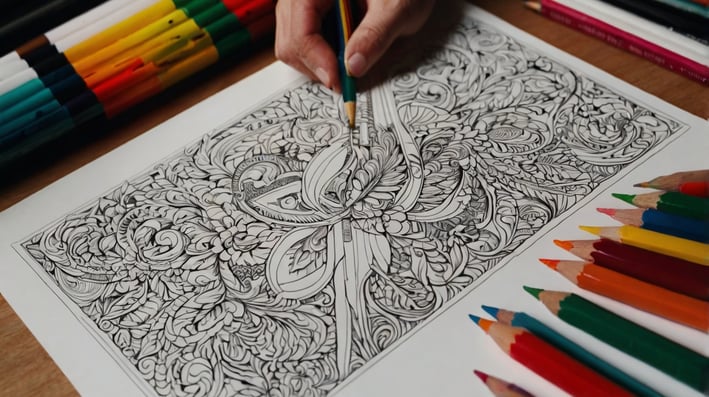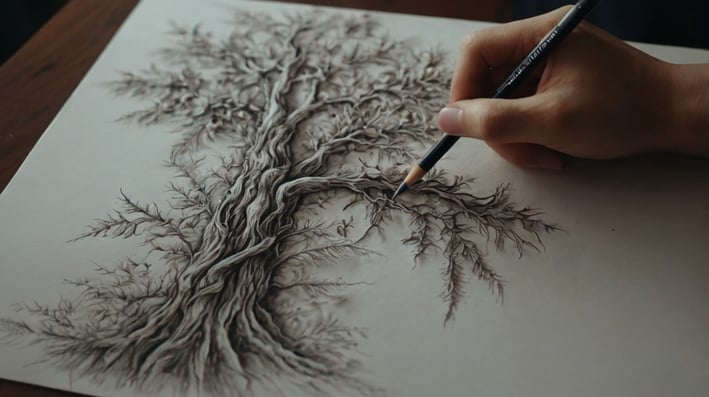
Mindfulness Through Art: Unlock Calm and Creativity with Coloring and Drawing
Learn how mindful coloring can reduce anxiety, improve mood, and enhance mindfulness for all ages. Discover how drawing and coloring can be a simple, effective way to practice mindfulness and relieve stress.
MINDFULNESSDAILY ACTIVITIES
Hey! You found me. Let’s Talk About Art and Mindfulness for Stress Relief. Specifically Drawing and Colouring.
Mindfulness—it’s one of those buzzwords that gets tossed around a lot these days. But honestly, it’s pretty amazing when you actually give it a shot. And what better way to practice mindfulness than through art? Yup, mindful coloring for anxiety is simple, easy to get into, and super effective. Let’s chat about why this is worth your time (and trust me, it is).
Why Mindfulness Through Art?
You might be wondering how doodling on a piece of paper could possibly help calm your mind. I get it. But hear me out. Art for stress relief gives you this magical space where you can either focus deeply on creating something (we call this “focused attention”) or just relax and let your hands move without overthinking (“open monitoring”). Either way, it’s a win for your brain and peace of mind.
A study by Carsley and Heath (2019) found that children who did mindfulness coloring felt less anxious about tests. Even something as simple as coloring can have a real effect on well-being, especially for kids who might find traditional mindfulness practices tough. Coloring helps kids stay present, focus on the moment, and forget about the stress of upcoming exams. It’s an easy way for parents and teachers to help kids manage anxiety.
Similarly, Mantzios and Giannou (2018) looked at how mindfulness coloring could help adults reduce anxiety and feel more present. It’s not just about the colors—it’s about the experience of focusing on something simple and repetitive. Their research showed that mindfulness coloring had a big impact on reducing anxiety, proving that this activity isn’t just for kids. It’s something we can all use to find some mental calm.
Start Small, Start Cheap
Mindful art is one of the easiest creative mindfulness techniques to begin with. You don’t need fancy supplies—a simple pencil and paper will do the job. Got a tablet? Even better—digital art works too. Once you start, you’ll see that there’s no bad time or place for a quick creative session. Midnight? Sure. Lunch break? Why not?
Mindfulness practices like coloring aren’t just helpful for young people. Studies show they also benefit older adults. Malinowski and his team (2017) found that doing regular, short mindfulness activities, like coloring, helped improve thinking skills and emotional health in older adults. For seniors, mindful coloring can be a fun way to stay mentally active and reduce stress. It’s all about finding something that brings peace while keeping the mind engaged.


Make It a Habit
Consistency is where the magic happens. You don’t need to go all out every day. Just spend five minutes—before bed, during lunch, whenever you can. Keep your art supplies handy so it’s easy to grab them. Bit by bit, it becomes a habit, and that habit becomes your little oasis of calm. One of the benefits of coloring for anxiety is how it helps you unwind and focus, even during tough times. In a recent study, Fong et al. (2022) found that mindful coloring helped nurses reduce stress during the COVID-19 pandemic. Nurses have incredibly stressful jobs, and activities like coloring provided an easy way to relax. It’s a great reminder that even small acts of mindfulness can have a big impact.
Art Benefits for Mental and Physical Health
If you’re dealing with physical challenges like chronic pain, mindful art can still be super helpful. Choi et al. (2021) found that mindful mandala coloring could significantly help with chronic pain. It’s amazing how focusing on colors and patterns can help shift your attention away from discomfort and bring you a sense of calm. Sometimes, mental relaxation is just as important as physical treatments.
Similarly, Barnes et al. (2019) studied how coloring helped chemotherapy patients manage stress. Cancer treatments can be really tough, both physically and mentally, and this study found that coloring was a great way to ease emotional stress. It’s simple, portable, and can bring a sense of comfort during tough times.


Let Your Creativity Run Wild
Drawing and coloring are just the beginning. You could also try origami, mosaics, painting, embroidery, or even craft your own creations using lights and fabrics. These are just some of the creative mindfulness techniques you can explore. Structured activities, like following a specific design, help improve focus, while unstructured activities encourage creativity and give you a sense of freedom.
And it’s not just for certain types of people—art is for everyone. Cross and Brown (2019) compared different art activities and found that both structured and unstructured ones could reduce stress and improve mood. Whether you prefer to color within the lines or love the freedom of a blank page, there’s something in art for everyone.
Mindfulness through art can even go beyond traditional supplies. Roquet and Sas (2021) worked on using technology to make mandala coloring more effective for treating depression. It’s just another way to show how creative expression, combined with mindfulness, can be a powerful tool for mental health.
Wrapping It Up
So, what are you waiting for? Mindful art is one of the best mindfulness activities for stress, proven to help everyone—from kids tackling test anxiety to adults managing work stress or chronic pain. Grab your materials, find a cozy spot, and let your mind wander. You’ll thank yourself later.
And hey, if it doesn’t work out (though I doubt it), come back and let me know. Until then, happy creating! Let’s make mindfulness through art a daily habit, one doodle at a time. Do you need materials to get started? Then check out Newbee Publications Because they have plenty of good materials to get you going. Find them here.


FAQs
Q: How does mindful coloring reduce anxiety?
A: Mindful coloring helps you focus on the present moment, which calms the mind and reduces feelings of anxiety. By concentrating on simple, repetitive actions like coloring, you can achieve a state of mental relaxation that effectively lowers stress levels.
Q: Is coloring suitable for older adults as a mindfulness activity?
A: Yes! Studies, like the one by Malinowski et al. (2017), show that mindful coloring can improve cognitive function and reduce stress in older adults, making it a fantastic activity for seniors.
Q: Can mindful coloring help with chronic pain?
A: Absolutely. Research by Choi et al. (2021) found that mindful mandala coloring helped individuals manage chronic pain by shifting their focus away from discomfort and fostering relaxation.
Q: What materials do I need to start mindful art?
A: You don’t need anything fancy—a pencil and some paper will do. If you have a tablet, digital art is a great option as well. The idea is to keep it simple and accessible so you can easily make it a habit.
Q: Can coloring be used in high-stress work environments?
A: Definitely. Fong et al. (2022) showed that brief mindful coloring sessions helped nurses manage stress during the COVID-19 pandemic. It’s an easy, quick activity that can fit into even the most hectic schedules.
References
Barnes, K., Joosub, K., Koko, M., Landman, E., Parak, N., Nel, C., & Joubert, G. (2019). The acceptability of colouring in as a mindfulness activity to reduce distress among adult chemotherapy patients at Universitas Academic Hospital, Bloemfontein. South African Journal of Oncology, 3, 3. https://doi.org/10.4102/sajo.v3i0.84
Carsley, D., & Heath, N. L. (2019). Evaluating the effectiveness of a mindfulness coloring activity for test anxiety in children. The Journal of Educational Research, 112(2), 143-151. https://doi.org/10.1080/00220671.2018.1448749
Choi, H., Hahm, S. C., Jeon, Y. H., Han, J. W., Kim, S. Y., & Woo, J. M. (2021). The effects of mindfulness-based mandala coloring, made in nature, on chronic widespread musculoskeletal pain: randomized trial. Healthcare, 9(6), 642. https://doi.org/10.3390/healthcare9060642
Cross, G., & Brown, P. M. (2019). A comparison of the positive effects of structured and nonstructured art activities. Art Therapy, 36(1), 22-29. https://doi.org/10.1080/07421656.2019.1564642
Fong, J. S. Y., Hui, A. N. N., Ho, K. M., Chan, A. K. M., & Lee, A. (2022). Brief mindful coloring for stress reduction in nurses working in a Hong Kong hospital during COVID-19 pandemic: a randomized controlled trial. Medicine, 101(43), e31253. https://doi.org/10.1097/MD.0000000000031253
Holt, N. J., Furbert, L., & Sweetingham, E. (2019). Cognitive and affective benefits of coloring: two randomized controlled crossover studies. Art Therapy, 36(4), 200-208. https://doi.org/10.1080/07421656.2019.1645498
Malinowski, P., Moore, A. W., Mead, B. R., & Gruber, T. (2017). Mindful aging: the effects of regular brief mindfulness practice on electrophysiological markers of cognitive and affective processing in older adults. Mindfulness, 8, 78-94. https://doi.org/10.1007/s12671-015-0482-8
Mantzios, M., & Giannou, K. (2018). When did coloring books become mindful? Exploring the effectiveness of a novel method of mindfulness-guided instructions for coloring books to increase mindfulness and decrease anxiety. Frontiers in Psychology, 9, 56. https://doi.org/10.3389/fpsyg.2018.00056
Roquet, C. D., & Sas, C. (2021). A mindfulness-based brain-computer interface to augment mandala coloring for depression: Protocol for a single-case experimental design. JMIR Research Protocols, 10(1), e20819. https://doi.org/10.2196/20819


Until Next Time...
